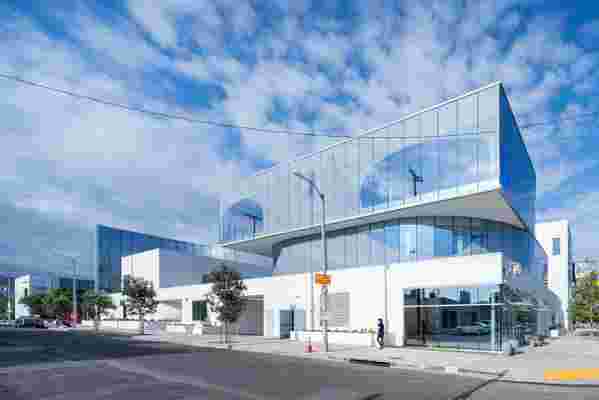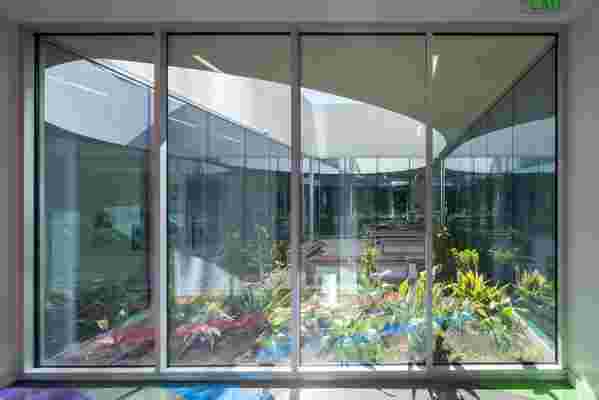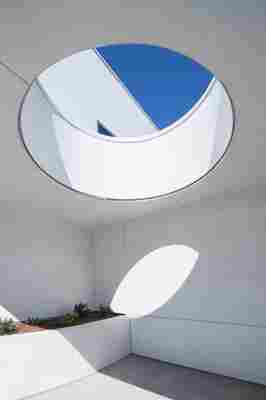The word Hollywood brings visions of the glitz, glamor, and fame of the entertainment industry to mind. However, on the streets of this Los Angeles neighborhood, there’s quite a different plotline. According to annual data from the Los Angeles Homeless Services Authority, there were more than 1,680 people in Hollywood suffering from homelessness in 2018. And in the city overall, 40 percent of people living rough identify as lesbian, gay bisexual, transgender, or queer (LGBTQ), says the nonprofit Los Angeles LGBT Center. The recent completion of the latter’s new Anita May Rosenstein campus could not have been more timely.

Whitewashed stucco covers the ground floor structures topped with volumes with glass façades. The glass has a white frit for heat protection with three large cutouts that mimic the Center's logo and a spotlight.
“We started the project in 2014. Fast-forward two years and President Trump gets elected; the LGBTQ landscape totally shifts and it becomes even more important,” reveals architect Dominic Leong, whose New York– and L.A.-based firm Leong Leong, which he heads with his brother, Chris, designed the 180,000-square-foot campus in Hollywood with local firm KFA. (KFA also served as executive architect.) The project brief described the LGBT Center’s want to create a “utopia” for the clients it serves—42,000 LGBTQ people each month, more than any other organization in the world—with health, housing, cultural, educational , and social services, while synthesizing 12 programs within a single site, including 100 beds for homeless youth, administrative offices, and comprehensive housing services that allow an at-risk youth to move from youth housing to apartment-style living to senior housing without displacement.

Interior courtyards with lush plantings bring light into the deep floor plate of the campus.
With a complex, multifaceted program and desire to give the Center street presence, the Leong brothers turned to designers Le Corbusier and perhaps surprisingly, Frank Gehry , for architectural inspiration. “We set out to create a porous but connected campus that oscillates between inside and outside to take advantage of the California environment,” Dominic describes. For scale, they looked at the Spanish Colonial courtyard houses typically found in Hollywood. And for institutional context, they thought about the mat building, a horizontal structure punctured by courtyards and championed by Le Corbusier in projects like the 1965 Venice Hospital. A stucco exterior on the ground floor with glass extrusions above was inspired by Gehry’s early residential work in L.A. vernacular.

A circular light well.
An interior courtyard with benches.
While the design may seem disparate from the street level, an aerial view reveals a mosaic-like organization. Separating campus elements by open-air, landscaped spaces also meets safety requirements for the private programs and allows light to permeate a deep floor plate. The most dynamically designed structure is a flexible building oriented toward the Village at Ed Gould Plaza across the street, an existing Center facility for cultural events and senior needs. It sits on a new public plaza to extend the Center's physical connection and serves as the public entrance. Five other, more discrete entrances invite the LGBTQ community into different programs, from the transitional housing to the senior center. Phase one, completed last month, is 70,000 square feet. In 2020, construction is expected to wrap up on the final phase, senior housing and apartment-style housing that will make up the remaining 110,000 square feet.
A view of the campus from Santa Monica Boulevard in Los Angeles.
“It’s not often that new buildings are created for a community that historically hasn’t had a civic presence or had architecture speak for it,” says Chris of Leong Leong's largest project to date. “That’s what was so powerful to us about it: Architecture can give a voice, address needs, and also create a civic presence in the community.” The LGBT Center celebrates its 50th anniversary this year, as do the Stonewall riots, the catalyst for the gay rights movement in the U.S. While the current administration has taken steps to erase these rights, the nonprofit remains optimistic. Sums up Dominic: “The Center’s CEO, Lorri Jean, said that she hoped it would be the first and last project of its kind. At some point, we evolve to where we don’t have to have dedicated campuses for the LGBTQ community because our society is inclusive.”
